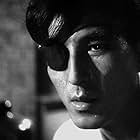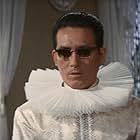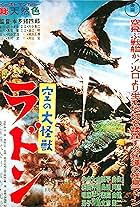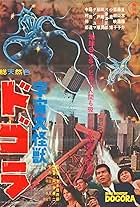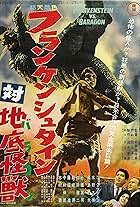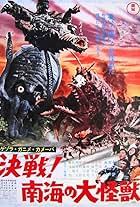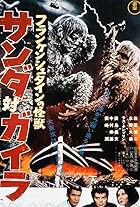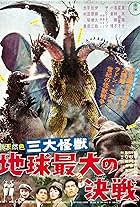Original Japanese version. Research in the Tohoku region comes across a monster known to the locals as the mountain god Baradagi.Original Japanese version. Research in the Tohoku region comes across a monster known to the locals as the mountain god Baradagi.Original Japanese version. Research in the Tohoku region comes across a monster known to the locals as the mountain god Baradagi.
- Directors
- Writers
- All cast & crew
- Production, box office & more at IMDbPro
Storyline
Did you know
- TriviaThis film began as a direct-to-television co-production between AB-PT and Toho, and thus was shot in black and white in the Academy aspect ratio. AB-PT went bankrupt during production, but a two-part TV film was still completed. The two parts were then edited into a single, longer feature film to be shown in Japanese theaters, which involved extending and re-recording the musical score, shortening scenes and adding new ones. This theatrical feature was then cropped shot by shot and released in an ersatz anamorphic widescreen format apparently adapted from SuperScope called TohoPanScope. Neither the TV version nor the theatrical version of this film exist in the Academy ratio, but the fully mixed audio track for the TV version still exists as of this date.
- GoofsSeveral short clips of Varan's attack on Tokyo are actually stock footage from Godzilla (1954), including a shot of Godzilla's tail smashing into a building and a POV shot from inside a warehouse of Godzilla's foot caving the structure in. Similarly, Varan's roar is an amalgamation of various Toho giant monster roars, including that of Godzilla himself.
- Alternate versionsThe scene of Baran (aka Varan) flying is deleted from the American version of the film.
- ConnectionsEdited into Varan the Unbelievable (1962)
Featured review
One of the better of the early Toho monster epics, the film suffers from a lack of definition. We don't really know where this monster comes from, or why he's so pee-ed off he wants to stomp Tokyo. Also, he never even quite gets to Tokyo, which is major disappointment - what good is a Japanese monster movie where Tokyo doesn't get stomped.
I suspect that the secret to this problem lies in the original score for the film, by the great Akira Ifikube. Godzilla fans should recognize variations on three essential themes for other movies - for "Godzilla", "Rodan", and "Mothra". Yet they are not just borrowed sound-tracks from those films, but actual variations. Apparently Ifikube used composition for this film as a kind of notebook on themes that would later get improved on again and again. My sense is that this is true of the film as a whole, that director Honda and crew used this film as a test-case for work on later films - the kaiju film industry was about to go wide-screen and technicolor in a big way, but the exact formula for the genre had not yet come together. I think they were using this film to get it together.
In its favor, I remark the film is narratively tight, so that not much time is wasted on the back-stories. It is what it is, a straight-out rubber-monster stomp, and begs to be enjoyed for that, and nothing more.
By the way, the subtitled DVD release from Animego has a couple fascinating bonuses to it - an interview with one of the special fx crew, as well as a demonstration of the technique used to manufacture the monster's costume. The film itself is enjoyable, if no great shakes, but bits of film-history like this are priceless.
I suspect that the secret to this problem lies in the original score for the film, by the great Akira Ifikube. Godzilla fans should recognize variations on three essential themes for other movies - for "Godzilla", "Rodan", and "Mothra". Yet they are not just borrowed sound-tracks from those films, but actual variations. Apparently Ifikube used composition for this film as a kind of notebook on themes that would later get improved on again and again. My sense is that this is true of the film as a whole, that director Honda and crew used this film as a test-case for work on later films - the kaiju film industry was about to go wide-screen and technicolor in a big way, but the exact formula for the genre had not yet come together. I think they were using this film to get it together.
In its favor, I remark the film is narratively tight, so that not much time is wasted on the back-stories. It is what it is, a straight-out rubber-monster stomp, and begs to be enjoyed for that, and nothing more.
By the way, the subtitled DVD release from Animego has a couple fascinating bonuses to it - an interview with one of the special fx crew, as well as a demonstration of the technique used to manufacture the monster's costume. The film itself is enjoyable, if no great shakes, but bits of film-history like this are priceless.
- How long is Varan?Powered by Alexa
Details
- Release date
- Country of origin
- Language
- Also known as
- Baran: Monster from the East
- Filming locations
- Production company
- See more company credits at IMDbPro
- Runtime1 hour 27 minutes
- Color
- Sound mix
- Aspect ratio
- 2.00 : 1
Contribute to this page
Suggest an edit or add missing content











